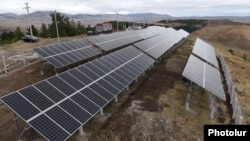Armenia will likely stop using natural gas and rely only on nuclear energy, hydropower and other renewables in meeting its electricity needs by 2030, a senior government official said on Wednesday.
“Our goal is to have by 2030 only nuclear and renewable sources of internal [electricity] consumption, which means that gas-powered thermal power plants will operate only for the purpose of exports,” Deputy Energy Minister Hayk Harutiunian told a news conference.
Harutiunian argued that the nuclear and renewable sources of energy are considerably cheaper than electricity generated by the plants using mainly Russian gas.
According to the National Statistical Service (NSS), thermal plants accounted for 37 percent of Armenian electricity production last year. By comparison, the Metsamor nuclear power station had a roughly 33 percent share in the total. The remaining 30 percent came from hydroelectric plants, NSS data shows.
Energy Minister Ashot Manukian said earlier this year that his ministry is aiming to ensure that renewable sources meet at least half of Armenia’s energy needs within the next few years. That is essential for boosting the country’s “energy security,” he said.
Hydropower provided only one-fifth of the country’s electricity a decade ago. Its output will rise further following the planned construction of a 76-megawatt plant on the Debed river flowing through the country’s northern Lori province.
The success of the government’s ambitious strategy will greatly depend on a rapid spread of solar energy. In Harutiunian’s words, its presently negligible share in national electricity production should reach at least 20 percent by 2030.
The Ministry of Energy Infrastructures and Natural Resources announced on March 30 that a consortium of Dutch and Spanish companies has won an international tender for the construction of Armenia’s first large solar power plant. Harutiunian said work to build the 55-megawatt plant near the eastern coast of Lake Sevan is due to be completed by the end of 2019. The state-of-the-art facility will have more than 170,000 solar panels, he said.
The deputy minister stressed the significance of the $50 million project which will be mostly financed by the World Bank. “It can be said that this project has broken all kinds of stereotypes about solar technologies: that they are expensive, that a lot of time is needed to introduce them in Armenia,” he said.
The winners of the tender have pledged to set a “very low tariff” for electricity to be produced by the Masrik-1 solar plant, added Harutiunian.
Harutiunian’s ministry has also pledged to facilitate the construction of five other large or medium-sized solar plants in the coming years. They would increase Armenia’s combined solar capacity to at least 120 megawatts.





Facebook Forum